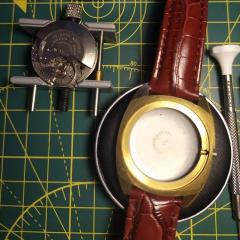-
Recently Browsing
- No registered users viewing this page.
-
Topics
-
Posts
-
hmmmm.... maybe there is a way to skin that cat 🙀 let me think on it... unless anyone else has any ideas? I left the opening in the side of the base and ring quite large to maybe allow you to grip the crown, but appreciate this may not always be possible, especially for small movements where the crown will not extend past the outer wall of the holder. I noticed this also, but after using the holder for a while I noticed that the ring/holder began to wear into shape (rough edges/bumps worn off) and the size became closer to the desired movement OD. Maybe with some trial and error we could add 0.5 mm (??) to the movement OD to allow for this initial bedding-in?
-
Hi nickelsilver, thanks for the great explanation and the links! I'll take a good look in the article. Especially this is great news to hear! Looking through forums and youtube videos I was informed to 'fist find a case and then fit a movement for it'. But seems that's not the case for pocket watches at least? I guess I should be looking to find some 'male square bench keys' for now. I was thinking of winding the mainspring using a screwdriver directly, but I found a thread that you've replied on, saying that it could damage the spring.
-
Murks, The rate and amplitude look OK, and the amplitude should improve once the oils you have used get a chance to move bed-in, also I notice that you are using default 52 degrees for the lift angle, if you get the real lift angle (assuming it's not actually 52) this will change your amplitude - maybe higher, maybe lower. I notice that the beat error is a little high, but not crazy high. At the risk of upsetting the purists, if the balance has an adjustment arm I would go ahead and try and get this <0.3 ms, but if it does not have an adjustable arm then I would probably leave well alone. Just my opinion.
-
Maybe I'm over simplifying this and I'm a little late to the discussion, but just by my looking at oil when I use it on a treated cap jewel the oil stays in one nice bubble, but when I don't it spreads out to the edges of the jewel. I'm not sure (but could well be wrong) but the analogy of a waxed car and rain is accurate in this case, the wax is very hydrophobic and repels the water, however, the process epilame works by is a different physical process based upon cohesion/adhesion (oleophilic) not repulsion (oleophobic) at least as far as I have read/observed. If one were to use a oleophobic substance equivalent to wax (hydrophobic) then one would need to create a donut shape to fence in the oil, however if one used such a strategy with a epilame which is oleophilic then the oil would sit on the ring of the donut and not in the 'donut hole', exactly where you don't want it. Even if the oil is smeared then the oleophilic epilame should pull it back to the center (see diagram below). Reference For interest the chemical in epilame is 2-(PERFLUOROHEXYL) ETHYL METHACRYLATE, CAS NO: 2144-53-8
-







Recommended Posts